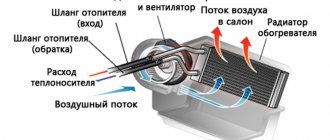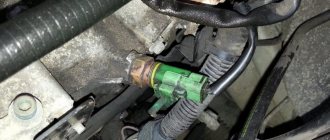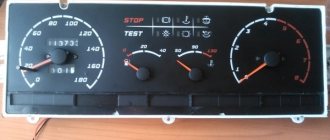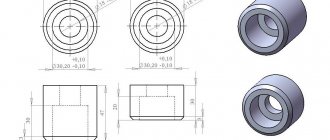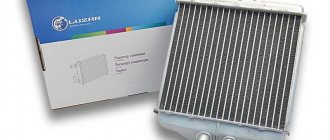Stove
, also known as
a heater radiator
, in a car performs the same function as in any other place - it heats the space, in this case the interior.
In addition, it is intended to prevent glass fogging. According to the norm, at 25 degrees below zero, the temperature inside the car must be at least +16 to ensure the driver’s normal condition and comfortable operation of the vehicle. It is for this purpose that the interior heater was invented. photo gallery:
Design and operating principle
Structurally, the interior stove
the car is nothing complicated. Heat is transferred to the air in the cabin from the running engine. The heated antifreeze, which circulates through the engine cooling system, also enters the heating system, where it enters the stove radiator, which acts as an apartment battery. The fan drives outside air through the radiator honeycombs, which is warmed up in this way and enters the cabin through the air ducts. The antifreeze that passes through the heater radiator immediately returns to the engine, and this circulation ensures a constantly high radiator temperature. This is exactly how the heater stove functions on the vast majority of car models.
Diagram of operation of a car interior heater
The temperature in the cabin is regulated differently for different cars. In cheaper models, you can only control the distribution of the incoming air flow and the speed of the blower fan. In more expensive models, you can quite accurately adjust the temperature of the air itself.
How to understand that the heater radiator is faulty?
Below are five main signs that indicate this particular problem. It is quite simple to understand that the heater radiator has malfunctioned or is out of order. But replacing this radiator is not an easy task.
Important information! Only one or a few signs of a heater core malfunction may appear at a time, but there are situations in which these signs appear all at once. This mainly depends on the age and condition of the car at the time the radiator failed.
Foggy windows
The very first sign of a malfunctioning heater core is sudden fogging of the inner surface of the windows without any obvious reason. Fogging of the windows does not mean slight fogging of the edge of the windshield, but the abundant formation of warm condensation over the entire area of all the windows of the car.
It is possible that while the car was moving, that is, after the engine had warmed up sufficiently, damage to the heater radiator occurred. As a result, heated coolant entered the cabin and caused condensation to form. The thing is that until this moment the liquid circulated in a warm temperature-controlled cooling system, and once in the cabin with a lower air temperature, it began to turn into steam.
Smell of melon
Regardless of whether your car's windows are fogged up due to damage to the heater core, the most unmistakable sign of a leaking heater is the appearance of a sweet, fruity smell in the cabin. This is what coolant smells like, so this smell definitely indicates it is leaking.
If you smell that pleasant smell from the outside of your car, look underneath to see how much coolant has leaked onto the ground.
Excessive coolant consumption by car
If your vehicle (it could be a car, truck, or minivan) suddenly develops a voracious appetite for coolant, and you don't understand why this happened, check to see if the heater core is damaged. If it was not possible to quickly detect the leak, it is likely that the liquid leaked into the cabin from a cold system, so the windows did not fog up, but a puddle formed. The first thing you should check is the floor in front of the front passenger seat. If the floor is wet and these are not wet footprints from shoes or a bag, then the whole issue is a faulty heater core.
Brr! It's cold in the cabin!
Low air temperature in the car interior is not always a sign of a malfunction of the heater radiator. The fan motor or other heater component may have failed (which is a good thing, since replacing some components can be much cheaper than replacing the radiator). But if the lack of heat in the cabin is accompanied by other signs, this indicates a problem with the heater core.
If there is a hole or puncture in the heater core, warm air may escape too quickly before reaching the other end of the heater ducts. Warm, barely warm, or even completely cold air may enter the cabin, depending on the degree of damage.
The engine is hot but the interior is cold
If you notice that the engine has overheated or continues to overheat, you should definitely check the condition of the heater core. But keep in mind that many other factors can cause engine overheating. If the radiator has stopped supplying heat to the vehicle interior, but the engine is still warm, find out if there is a coolant leak at any other point or if other problems have arisen.
Overheating of the engine is extremely dangerous, since it also heats up other critical components of the car, as a result of which they begin to wear out quickly and fail in record time.
If the engine begins to overheat, you should find out the cause as soon as possible and eliminate the malfunction.
If the temperature gauge arrow reaches the red zone, stop using the car and call a tow truck to take the car to a repair shop. Of course, you can ignore these recommendations, but believe me, in this case you will learn a good lesson.
Existing types of heaters
The stove described above is called liquid. In addition to it, in new cars there are also liquid electrically heated and air heaters, which are most often used as additional heating for the car.
Stove radiator design.
The operating principle of liquid electric heated stoves is similar to the functioning of standard liquid heating stoves. Only in this case, not the heat of the engine is used to heat the air, but water heated by the heater. The pipes through which air enters the cabin pass through a tank filled with hot water, which provides the necessary heating of the air flow. In this case, the stove radiator is a tank of water.
Air heaters work on a similar principle, only here the air passing through a chamber heated to the required temperature is directly heated. Such systems are often used as additional heating for the interiors of large vehicles, for example, those converted from freight to passenger minibuses. The heater radiator here is compact, so the device can be placed without disturbing the aesthetics and functionality of the interior.
Heater radiator repair
If the radiator is faulty, it needs to be repaired, cleaned or replaced. The last option is the simplest, but also the most expensive. However, quite often you can restore the radiator yourself.
Soldering an aluminum stove radiator
Unlike copper, aluminum radiators are difficult to solder. An oxide film forms on the surface of aluminum, protecting the metal from corrosion, chemical and temperature influences. This film can be removed by mechanical surface treatment and the use of special means.
Before repairs, the heater radiator is removed from the car, after draining the antifreeze. It is then washed with running water and dried. If the location of the damage has already been identified, repairs begin. If the exact location of the damage is unknown, it is determined using a compressor and a container of water. All holes in the heat exchanger, except the thinnest one, are closed with plugs. The radiator is immersed in water, filling it through the remaining hole with air from the compressor. The location of the damage is easily determined by the appearance of bubbles.
To solder the radiator you will need a powerful soldering iron.
To solder the radiator you will need:
- powerful soldering iron of at least 250 W;
- special flux (F-59A, F-61A, 34A);
- special solder (TsOP-40, 34-A);
- pliers;
- set of files;
- sandpaper;
- acetone.
Soldering is carried out as follows:
- The damaged area is cleaned with a file and sandpaper and degreased with acetone.
- Flux is applied to the damaged area and heated with a soldering iron. You can use a gas burner for heating, but the flux in this case can quickly burn out. The tip of a hot soldering iron applies flux to the crack.
- Solder (preferably in the form of a wire) is applied to the soldering area and melted with a soldering iron. After it spreads evenly over the crack, it is allowed to cool. Then the procedure is repeated.
- If the resulting seam has irregularities, they are removed with sandpaper.
When soldering a radiator, solder is applied to the damaged area in an even layer
Video: soldering the radiator
Cold welding and other repair methods
Radiator cracks can be repaired using cold welding. To do this, separate a piece of the substance, knead it in your hand and apply it to the damaged area. Once the weld has completely dried and hardened, the leak will disappear. In addition to cold welding, various liquid or powder sealants are offered on the market to eliminate internal mechanical damage to the radiator. Previously, car enthusiasts used mustard powder for this purpose, pouring it inside the heat exchanger. A good option for restoring the tightness of the radiator is argon welding.
Heating system malfunctions
Despite the simplicity of the design, the stove can also fail. The most common types of breakdowns are:
- problems with the pump;
- radiator clogged;
- broken or clogged faucet;
- air pockets in the heat exchange system;
- electronic malfunction of the stove fan.
If a leak or blockage occurs in the radiator, it is advisable to change it
on new.
If the pump is faulty, the interior may still heat up, but much worse than before. But the pump is broken
, this is not only a problem with the interior heating system, but also a malfunction of the engine cooling system, which is much worse, because because of this the cylinder head may fail, which automatically means a major overhaul of the car.
Also, the stove may not work properly due to a broken faucet, which becomes clogged with dirt or fails due to wear and tear. When the inlet hose near the heating radiator is hot, while the outlet remains cold, there is a problem with the faucet
. If after replacing the faucet the same symptoms remain, most likely the radiator itself is clogged with scale, which will also have to be replaced.
Airflow speed adjustment does not work - most likely the motor
or its
resistor
.
Airing problem
systems, due to the presence of an air bubble in the antifreeze circulation system that disrupts the flow, materials (videos and articles) from our website can be solved. Getting rid of it is simple: you need to warm up the engine, loosen the clamp on the hose going into the stove until a small gap forms, through which the air will bleed out.
When heating modes are not regulated
(some heater speed is not working), the fault lies in the fan resistor, or the motor may not spin at all due to an electrical or mechanical reason. On cars with a damper system, it is not uncommon for the heater to malfunction due to a malfunction of the damper drive to the desired position.
Ways to eliminate the causes of a malfunctioning stove in a car
Depressurization of the cooling system is considered the most common malfunction, which often leads to complex repairs that require large financial costs. Detecting an antifreeze leak is not at all difficult. First of all, it manifests itself in a decrease in the liquid level in the expansion tank.
If such a malfunction is detected, you should use an inspection hole or overpass to thoroughly check all components and elements of the cooling system for leaks. Leakage often occurs due to damage to the radiator, wear of pipes and other parts.
The air that enters the cooling system leads to malfunctions of the stove. In most cases, a faulty radiator and damaged pipes must be replaced.
In car dealerships you can find special additives that supposedly can eliminate leaks in the car’s cooling system. It should be noted that the use of such products can lead to clogging of thin radiator tubes.
Quite often there are car heater malfunctions caused by the fact that two different antifreezes were poured into the cooling system, which are incompatible with each other. Liquids that differ in composition, when interacting, coagulate and form an adhesive composition that clogs the channels of the radiator and other elements of the cooling system.
Eliminating such a malfunction is a rather complex process. To flush the system, special equipment and special compounds are required. Caustic soda works most effectively. After using the active substances, the system is washed with water. To clean the heater radiator from internal deposits, it is necessary to disconnect its external pipes. If flushing the system fails, the problem can only be eliminated by replacement.
If the cause of the stove malfunction is the accumulation of dirt on the radiator of the cooling system, it is necessary to disassemble the unit. After this, the radiator should be blown out with a stream of compressed air. The same method can be used to detect heavy contamination on the surface of the cabin filter. In winter, malfunctions of the stove may occur due to snow getting into the car's air intake.
We recommend
FAQ
How does a car heater work?
The stove fan draws in air from outside or inside the cabin and drives it through the honeycomb of the stove radiator, where it heats up. Then the heated air enters the cabin through the air ducts. The heating of the air itself occurs when hot coolant from the engine cooling system circulates through the radiator. We can say that the principle of operation of the stove is similar to the operation of conventional home radiators, only the distribution of air is regulated by a fan.
Independent search for the causes of a malfunction of the stove in a car or contacting a service station
The technology for troubleshooting the stove is selected depending on the cause of the breakdown and the make of the car. If a coolant leak or an air lock is detected, you can carry out the repair yourself. At the same time, if the cause of the breakdown is damage to the radiator or a malfunction of the control automation, then you cannot do without the help of professionals. Unqualified maintenance of the cooling system can lead to additional malfunctions and significantly increased repair costs.
Experts recommend performing an initial inspection of the machine to identify the causes of the stove malfunction (check the antifreeze level, fan operation, presence of air in the system or leaks, etc.). If such a check does not allow you to find out why warm air does not flow into the car interior, you need to contact car service specialists who will carry out professional diagnostics of the stove’s operation and eliminate any identified breakdowns.
Source
conclusions
As practice shows, most motorists replace the heater radiator without removing the dashboard or dashboard. This process is quite complex and requires a considerable amount of time. To increase the service life, it is recommended to flush the stove radiator with a special liquid.
Sources
- https://vsesvoimirykami.ru/zamena-radiatora-pechki-svoimi-rukami/
- https://autogrm.ru/vaz/prostaya-zamena-radiatora-pechki-na-priore-bez-kondicionera.html
- https://SwapMotor.ru/ustrojstvo-dvigatelya/zamena-radiatora-pechki.html
- https://pol-z.ru/remont-radiatora-pechki/
- https://autochainik.ru/ne-greet-pechka-v-mashine.html
[collapse]
